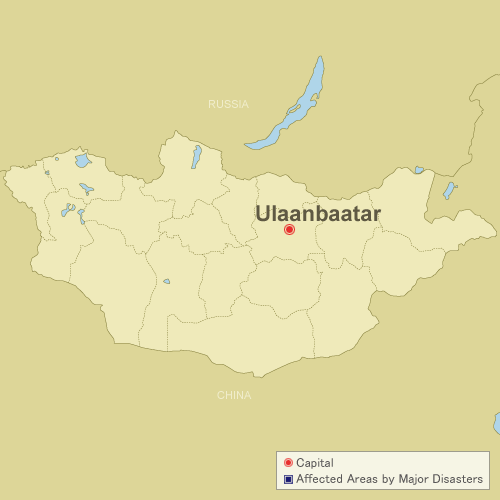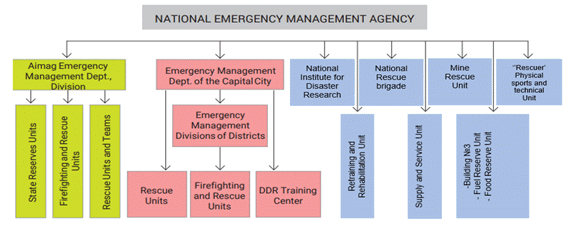TOP PAGE > Information on Disaster Risk Reduction of the Member Countries
Information on Disaster Risk Reduction of the Member Countries
 Mongolia
Mongolia
General Information
 Formal Name: Mongolia
Formal Name: MongoliaMongolia is landlocked between China and Russia, with a land area of 1,564,100 sq km. Western Mongolia is mountainous with Altai Mountains and Khangain Nuruu whose altitude are 4300 meters and 3500 meters, respectively. Southern part is covered with the Gobi Desert and the Mongol Plateau, whereas forests spread in the north, and prairie from the center to the east. Continental climate.
Population: 3,409,939 (2022). Mongolia is the country with the lowest average population density in the world. It has a little over 2 people per km2 (about 5 people per square mile). Mongolia’s population is 66% settled and 34% nomadic.
The capital is Ulaanbaatar.
Overview of Disasters
Major disasters are snow damage (dzud), flood, snow and dust storm, forest and steppe fire, animal disease, earthquake.
Recent Major Disasters
Forest and steppe fire (2012)
In 2012, a total of 229 forest and steppe fires broke out in 103 places over Mongolia. Due to the forest and steppe fires, 8 people injured and 4 people died. Also, more than 3 thousand livestock died and 55 houses were devastated, leaving many peoples homeless.
Dzud (2016)
In 2016, White dzud disaster occurred in most provinces of Mongolia. Temperatures plummeted, with minimum temperatures reaching minus 40 to minus 50 degrees and with heavy snowfall. Due to the white dzud, more then 1.0 million livestock died and about 8,000 households were severely affected.
Flash Floods (2021)
Flash floods occurred all around Mongolia due to prolonged heavy rainfall from 28 June to 29 July 2021. The rainfall averaged 46-60 mm (1.8-2.4 inches) across the country. 1,549 households in seven provinces suffered heavy losses due to flash floods and heavy rains.
Disaster Management System
Legal System
DRR and climate adaptation activities in Mongolia are being organized in accordance with the Mongolian Constitution, the Mongolian National Security Concept, the Law on Disaster Protection and national policies and programs on disaster risk reduction.
In 2003, the Parliament of Mongolia adopted the Law on Disaster Protection, where matters and roles relating to disaster protection were entrusted to state organizations, local authorities, NGOs, to the private sector and individuals. In terms of the restructuring of the legal environment, the Law on Disaster Protection was reformulated in accordance with international policies aimed at ensuring global sustainable development and DRR, and was approved by the Parliament in February 2017.
Within the legal framework on DRR, Mongolian Government implementing the following policy documents: "Vision for Sustainable Development in Mongolia-2030", "National Policies and Programs for Disaster Risk Reduction" (2011), the "The National Program of Community Participatory Disaster Risk Reduction" (2015) and the "Mid-Term Strategy to implement the Sendai Framework for Disaster Risk Reduction in Mongolia" (2017).
In 2003, the Parliament of Mongolia adopted the Law on Disaster Protection, where matters and roles relating to disaster protection were entrusted to state organizations, local authorities, NGOs, to the private sector and individuals. In terms of the restructuring of the legal environment, the Law on Disaster Protection was reformulated in accordance with international policies aimed at ensuring global sustainable development and DRR, and was approved by the Parliament in February 2017.
Within the legal framework on DRR, Mongolian Government implementing the following policy documents: "Vision for Sustainable Development in Mongolia-2030", "National Policies and Programs for Disaster Risk Reduction" (2011), the "The National Program of Community Participatory Disaster Risk Reduction" (2015) and the "Mid-Term Strategy to implement the Sendai Framework for Disaster Risk Reduction in Mongolia" (2017).
Organization
 According to the Law on Disaster Protection, National Emergency Management Agency (NEMA) is responsible for the implementation of the State disaster protection policy and legislation, as well as for the professional organization of nationwide activities. Therefore, disaster management in Mongolia is led by the NEMA.
According to the Law on Disaster Protection, National Emergency Management Agency (NEMA) is responsible for the implementation of the State disaster protection policy and legislation, as well as for the professional organization of nationwide activities. Therefore, disaster management in Mongolia is led by the NEMA.During a disaster response, NEMA is responsible for coordinating the activities of different stakeholders who are involved in disaster response including non-governmental and governmental organizations, the private sector, community groups, and international organizations.
Country Report
Country Report 2022 (English Version, PDF file)Country Report 2021 (English Version, PDF file)
Country Report 2013 (English Version, PDF file)
Country Report 2011 (English Version, PDF file)
Country Report 2010 (English Version, PDF file)
Country Report 2006 (Japanese Version, PDF file)
Country Report 2006 (English Version, PDF file)
Country Report 2002 (English Version, PDF file)
Country Report 1999 (English Version, PDF file)
Country Report 1999 (Japanese Version, PDF file)
Country Report 1998 (English Version, PDF file)

